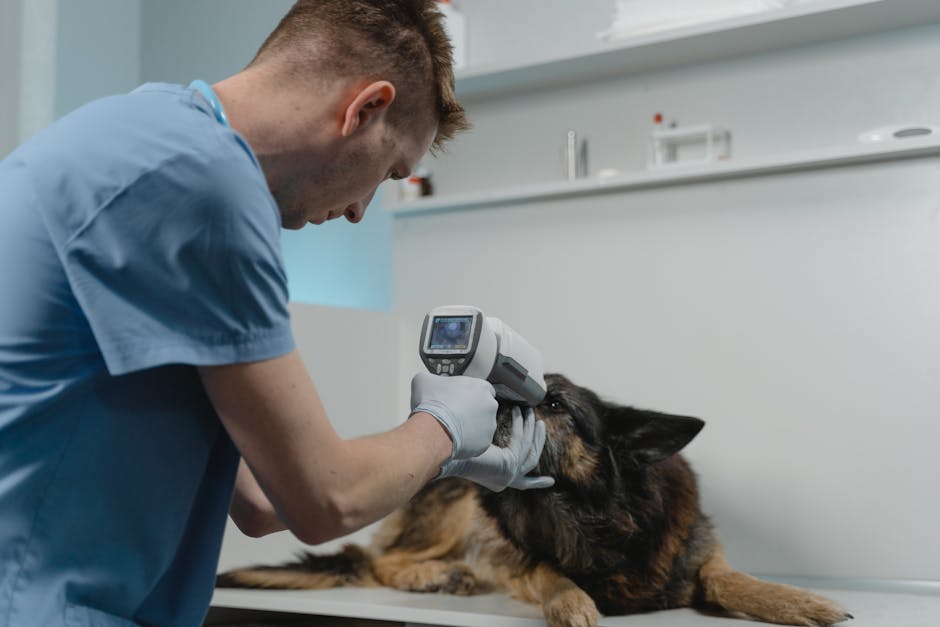The Amazing Latest Pet Technologies You Need to Try Today

Why the Latest Pet Technology is Changing Pet Care in 2024
Latest pet technology has exploded into a massive market worth nearly $500 billion globally by 2030, changing how we care for our furry friends. From AI-powered health monitors to smart feeding systems, these innovations solve real problems for busy pet parents.
Key pet tech categories:
- Smart collars and wearables – Track activity, heart rate, and GPS location
- AI health diagnostics – Spot illness early with 90%+ accuracy
- Automated feeding systems – Control portions and schedules remotely
- Interactive cameras and toys – Stay connected and reduce separation anxiety
- Telehealth platforms – Get vet advice without leaving home
- Smart home integration – Microchip doors, climate beds, and motion alerts
Americans spent $147 billion on pets in 2023, up from $90 billion just five years earlier. This surge reflects how pets have become true family members deserving high-tech care.
Busy millennials want peace of mind about their pets’ health and safety. Technology delivers that through real-time monitoring, early disease detection, and remote interaction capabilities that weren’t possible before.

Latest pet technology terms explained:
– Best dog training gadgets
– Best pet water dispenser
– Best self cleaning litter
The Latest Pet Technology Categories
The latest pet technology landscape is exploding with over 13.5% annual growth, fueled by “pet humanization.” The global pet monitoring camera market hit $498.7 million in 2023 and is racing toward $1.7 billion by 2030. Automatic pet feeders are projected to leap from $6.05 billion in 2022 to $13.1 billion by 2032. Scientific research on pet wearable market growth shows wearables are leading this revolution.
Modern pet parents want smart solutions across five major categories: Health & Safety Wearables track vital signs and location, Smart Home Integration automates feeding and climate control, AI Diagnostics detect health issues early, Interactive Entertainment keeps pets engaged, and Sustainable Solutions offer eco-friendly options.
Why the latest pet technology matters in everyday life
Preventive care has become a game-changer. Smart collars detect early illness signs with over 90% accuracy by monitoring heart rate, activity, and sleep patterns. Instead of waiting until symptoms appear, these devices alert you to subtle changes indicating brewing health problems.
Peace of mind is priceless for pet parents. With 76% of global pet owners willing to make major life changes for their pets, technology that keeps us connected feels essential. GPS tracking, live cameras, and health alerts create reassuring bridges between you and your pet’s wellbeing.
Cost savings often surprise people. Early detection prevents expensive emergency vet visits. Smart portion control tackles pet obesity affecting 60% of American dogs, reducing long-term health expenses.
How to evaluate the latest pet technology before you buy
Start with safety fundamentals. Look for waterproof ratings like IP68, battery life lasting 2-3 months, and 256-bit data encryption. Check that device weight won’t burden your pet.
Research real-world performance through verified pet owner reviews. Verify accuracy claims with independent testing and ensure smartphone compatibility. Always factor in subscription costs.
Get professional guidance from your veterinarian before investing in health monitoring devices. They can recommend trusted brands and discuss integration with your pet’s medical records.
Health & Safety Wearables

Latest pet technology in wearables is changing how we catch health problems before they become serious. The shocking reality: 60% of dogs in America are overweight, yet the same percentage of pet parents think their dog looks fine. Smart wearables provide objective health data that doesn’t lie.
The global market for AI technology in animal health is expected to hit $3.76 billion by 2030, growing at nearly 20% annually.
Modern pet wearables track heart rate patterns, sleep quality, temperature changes, and behavioral quirks like excessive scratching. When patterns shift, you get alerts that often catch problems weeks before visible symptoms appear. Early detection capabilities spot irregular heartbeats and fever spikes with over 90% accuracy.
Smart collars: the beating heart of latest pet technology
Smart collars have evolved from basic GPS trackers to AI-powered health assistants. The Fi Series 3 Plus and similar devices identify specific behaviors – barking, scratching, eating – with 80% accuracy. When your calm dog starts excessive scratching at 3 AM, you’ll get alerts revealing potential allergies before they worsen.
Activity tracking goes beyond step counting. Collars learn normal patterns and notice changes. If your energetic retriever becomes a couch potato, the collar flags this activity drop – often the first sign of joint pain or illness.
Heart rate monitoring establishes baseline vitals unique to your pet, then alerts you to significant changes. GPS and geofencing provide safety through real-time location tracking while revealing behavioral patterns that might indicate health concerns.
Modern smart collars run up to three months per charge and are waterproof to 50 meters.
Beyond collars: gait sensors & haptic vests
Gait analysis systems like Tendiboots™ detect lameness and movement problems human eyes miss. These sensors measure five movement parameters in 10 seconds, valuable for senior pets developing arthritis or breeds prone to hip problems.
Haptic guidance vests help blind dogs steer using cameras and gentle vibrations. The system detects obstacles up to eight meters away, guiding dogs around hazards through soft vibrations they feel. This technology gives blind pets confidence and independence to explore safely.
Specialized health monitors are emerging for specific breeds – respiratory monitors for flat-faced breeds, joint stress monitors for dogs with hip dysplasia. Pet technology is becoming more personalized for unique breed and health needs.
Smart Home Feeding, Water & Environment

The automated pet feeding market is booming – growing from $6.05 billion in 2022 to $13.1 billion by 2032. Latest pet technology in feeding solves real problems: managing different dietary needs for multiple pets, maintaining schedules during travel, and controlling portions for weight management.
Smart systems work together – your feeder talks to your pet’s activity tracker, adjusting portions based on exercise. Water fountains send alerts when consumption drops, often the first illness sign.
| Feature | Smart Feeders | Smart Water Dispensers |
|---|---|---|
| Portion Control | Precise measurements, customizable portions | Continuous fresh water, filtration |
| Scheduling | Multiple meals per day, custom timing | Automatic refill, flow sensors |
| Remote Control | Mobile app, voice commands | App notifications, level monitoring |
| Health Integration | Calorie tracking, weight management | Hydration monitoring, consumption alerts |
| Multi-Pet Support | Individual pet recognition | Shared access, usage tracking |
Precision feeding powered by latest pet technology
Smart feeders use sophisticated algorithms calculating optimal portions based on age, weight, activity level, and health goals. If your Golden Retriever had an extra-long hike, the feeder adds kibbles to dinner.
Mobile app control lets you adjust portions and feeding times remotely. Multi-pet households benefit from microchip recognition ensuring each pet gets their specific diet – no more food stealing drama.
For busy millennials, voice control through Alexa or Google Assistant is game-changing. More info about Best Pet Water Dispenser shows how smart hydration monitoring complements feeding innovations.
Creating a tech-enabled sanctuary at home
Smart pet doors like the Wayzn Smart Pet Door offer AI calibration and 256-bit encryption with motion activation, app-controlled schedules, and voice control. They keep pets safe while preventing unauthorized visitors.
Climate-controlled bedding automatically adjusts temperature based on your pet’s body heat. For senior pets with arthritis, consistent warmth makes the difference between good and painful days.
Environmental monitoring tracks air quality, humidity, and temperature, helping identify environmental triggers for allergies or respiratory issues. The real magic happens when systems work together, creating connected ecosystems that learn your pet’s patterns.
AI Diagnostics & Remote Veterinary Care

Latest pet technology powered by AI is achieving diagnostic accuracy rates over 90% for many conditions. The global AI animal health market is exploding due to veterinarian shortages and pet owners demanding faster, more accurate health answers.
Image analysis technology examines photos of your pet’s eyes, skin, and teeth with 93% accuracy. Predictive X-ray systems spot joint problems before they become painful. Behavioral pattern recognition catches illness signs you might miss.
Telehealth, chatbots & the latest pet technology revolution
Telehealth platforms have completed over 1 million pet consultations, proving pet parents desperately want accessible veterinary guidance. The convenience factor is game-changing for those “is this normal?” moments at 9 PM on weekends.
Round-the-clock peace of mind comes from platforms operating extended hours (6 AM to 12 AM ET). Transparent pricing makes guidance accessible – virtual consultations cost $30-60, dramatically less than traditional visits.
Smart triage systems powered by AI chatbots assess symptoms and recommend appropriate care levels. How to Choose the Best Pet Technology for Your Pet’s Health offers guidance on selecting diagnostic tools.
Important limitations: These platforms can’t prescribe medications or provide official diagnoses. They should improve, not replace, regular veterinary care.
From machine-vision to drug findy
Predictive imaging systems in South Korea analyze X-rays and predict 22% chance of knee dislocation in breeds like Goldendoodles. Imagine catching joint problems before your pet shows pain signs.
Smart document analysis helps veterinarians quickly parse complex medical histories, spending more appointment time focusing on your pet rather than shuffling paperwork.
Bias-free diagnostics ensure AI systems are trained on diverse datasets covering all breeds and conditions. Accelerated drug development analyzes genetic data and treatment responses across massive animal populations, potentially bringing life-saving medications to market faster.
Interactive Cameras, Toys & Enrichment
The pet monitoring camera market has grown from $498.7 million in 2023 to an expected $1.7 billion by 2030. Latest pet technology has transformed simple surveillance into interactive experiences that strengthen bonds between you and your pet.
Modern pet cameras offer two-way audio and video for real conversations with your pet. Treat dispensing features reward good behavior and play interactive games. AI-powered behavior analysis creates daily activity diaries, tracking sleep, play time, and eating habits while spotting concerning changes.
Strengthening bonds with the latest pet technology
Interactive cameras become part of daily routines – pet parents check in during lunch breaks or say goodnight through cameras. Two-way communication helps pets with separation anxiety stay calmer. Some pets actually “talk back” through cameras, creating genuine conversations.
Smart motion detection differentiates between normal zoomies and destructive behavior, sending specific notifications when intervention might be needed. AI behavior diaries provide eye-opening insights – you might find your “lazy” cat is quite active during certain hours.
Mental stimulation on autopilot
Smart puzzle toys create adaptive challenges that grow with your pet’s abilities, starting simple and increasing difficulty as pets master each level. They track progress and adjust challenges based on mood or energy.
Robotic companions initiate play sessions, respond to energy levels, and provide comfort during stress. They learn individual preferences – some pets prefer gentle movements while others want high-energy play.
Customizable routines set different entertainment schedules throughout the day. The beauty of automated stimulation is consistency – smart systems ensure appropriate mental enrichment is always available, reducing boredom-related behavioral issues.
Sustainable & Future-Proof Innovations

The latest pet technology is getting a green makeover as pet parents become more environmentally conscious. Manufacturers are responding with biodegradable device components, solar-powered charging systems, and recyclable materials creating a circular economy in pet tech.
These eco-friendly innovations often perform better than traditional alternatives. Solar-powered GPS trackers can operate indefinitely in good weather, eliminating dead battery frustrations.
Greener gadgets for mindful owners
Smart toys made from plant-based plastics look and feel like traditional versions but break down naturally at end-of-life. Solar charging technology in GPS trackers and smart collars features tiny panels extending battery life by weeks or months – some achieve “infinite operation” from daily sunlight.
Smart waste management systems tackle pet ownership’s less glamorous aspects with automated composting systems and biodegradable bags integrated with smart dispensers. Eco-Friendly Pet Products You Need to Try showcases more sustainable innovations.
Energy efficiency improvements mean devices monitor pet health 24/7 while sipping power. Smart power-saving modes automatically activate during rest periods.
What’s next in the pipeline?
Virtual pet companions powered by Large Language Models are being developed for people who can’t care for real animals due to allergies or housing restrictions. These AI systems combine emotional intelligence with realistic behaviors.
Advanced robotics will offer sophisticated interactions beyond today’s basic toys. Predictive genomics will predict health risks decades in advance and recommend optimal nutrition based on genetic profiles.
Brain-computer interfaces might enable direct communication between pets and technology, allowing intuitive device control and unprecedented insight into animal emotions.

Frequently Asked Questions about Cutting-Edge Pet Tech
Are smart collars safe for all breeds?
Smart collars are safe for most pets weighing 7-70 kg, covering beagles to German shepherds. Very small dogs under 7 kg might struggle with standard collars that feel too heavy.
Flat-faced breeds like bulldogs and pugs need special attention because their unique breathing patterns can affect how health monitors read vital signs.
Safety checklist:
– Proper fit – slide two fingers under the collar easily
– Watch for irritation during the first week
– Remove periodically to let skin breathe
– Choose lightweight options for small, senior, or sensitive pets
Always consult your vet before using wearable tech, especially if your pet has existing health issues.
How accurate is AI in spotting health issues?
Smart collar health monitoring hits over 90% accuracy for activity changes and vital signs. Image analysis apps achieve 93% accuracy for skin conditions, eye problems, and dental issues. Behavior detection sits around 80% accuracy for identifying specific activities.
AI is incredibly helpful but not magic. Think of it as a smart assistant spotting patterns you might miss, not a veterinarian replacement. False positives can cause unnecessary panic, while false negatives might give false confidence.
Best approach: Use AI as an early warning system, then verify concerning alerts with your vet.
Can I rely solely on automated feeders?
Automated feeders excel at consistent schedules, portion control, handling multiple pets with different diets, and ensuring pets eat when you’re delayed.
However, they can’t notice choking, eating struggles, or behavioral changes around food. Technology can fail – feeders might malfunction and dump excessive food or get jammed, leaving pets hungry.
Recommendation: Use automated feeders as part of your routine, not as complete replacement for being present. They’re perfect for maintaining schedules and portions, but pets still need you as their primary caregiver.
Conclusion
The latest pet technology has transformed from a niche market into a billion-dollar industry revolutionizing pet care. Americans spent $147 billion on pets in 2023, with the global market projected to reach $500 billion by 2030.
Smart collars monitoring heart rates are becoming as common as ID tags. Automated feeding systems help tackle pet obesity affecting 60% of American dogs. AI diagnostic tools provide instant health assessments with over 90% accuracy, while interactive cameras ease separation anxiety.
This technology works best when it improves the human-pet relationship, not replaces it. Successful pet parents use these tools to become more informed caregivers, catching health issues earlier and providing better nutrition.
Getting started is simple. Begin with basics like a smart collar for health monitoring or automated feeder for portion control. Always check safety ratings, battery life, and data security. View these tools as partners in pet care – they provide valuable data, but your love and veterinary guidance remain irreplaceable.
The landscape changes rapidly, with sustainable materials, AI diagnostics, and virtual companions pushing boundaries we couldn’t imagine years ago.
At Best Pet News, we help you steer these developments. Our Pet Care Trends section keeps you updated on innovations benefiting your pet’s specific needs.
Your pet’s health and happiness have never been more measurable or manageable. The future of pet care is here, waiting to help you give your beloved companion the best life possible.

